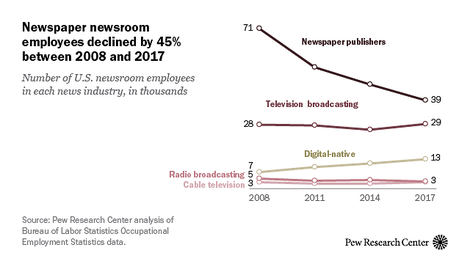Your podcast discovery platform
Curious minds select the most fascinating podcasts from around the world. Discover hand-piqd audio recommendations on your favorite topics.

piqer for: Global finds Globalization and politics Technology and society
Turkish journalist, blogger and media expert. Writes regular columns for The Arab Weekly and contributes to Süddeutsche Zeitung, El Pais and the Guardian. An European Press Prize Laureate for 'excellence in journalism' in 2014, Baydar was awarded the prestigious 'Journalistenpreis' in Germany by Südosteuropa Foundation in February 2018.
Newsrooms In The U.S.A. Note A Massive Decline In Employment
Across the globe, the bitter fact reminds of itself every day: Newspapers and print editorials are bleeding — faster and faster.
The American press is in the lead. A new study by Pew Research Center shows the intensity of the decline, which erodes the backbone of journalism, in the newsrooms.
From 2008 to 2017, newsroom employment in the U.S. dropped by 23%. In 2008, about 114,000 newsroom employees — reporters, editors, photographers and videographers — worked in five industries that produce news: newspaper, radio, broadcast television, cable and “other information services” (the best match for digital-native news publishers). By 2017, that number declined to about 88,000, a loss of about 27,000 jobs ... Newspaper newsroom employees dropped by 45% over the period, from about 71,000 workers in 2008 to 39,000 in 2017.
Such a decline has never been witnessed in journalism, a key sector in any functioning democracy, or the emerging ones.
Worth noting is that the trend is not limited to the U.S.A. The slow-motion collapse of print press is a pattern almost everywhere, although its pace and magnitude varies.
At the positive side, as Pew notes, the increase of employees at the digital news sector, and the relative stability at the broadcast news side.
Given the massive changes in public habits and growth of technology, nothing suggests that the trend will reverse at any rate.
